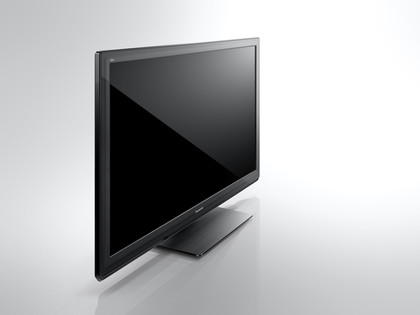Why you can trust TechRadar

The TX-P50ST30B might seem like good value in terms of features, but when it comes to ultimate picture quality we found it slightly disappointing.
Let's start with the 2D-3D mode, which we used while watching Doctors on BBC HD. Whatever was in focus seemed to be slightly divorced from the background, sometimes impressively so, but mainly it looks plain odd – and the background flickers to a distracting extent.
Back on 2D, the TX-P50ST30B's contrast levels are not quite up there with the best Panasonic plasmas. Despite this panel sporting an anti-reflective coating to boost perceived contrast, we weren't completely blown away by the dingier scenes in our test disc, Despicable Me on Blu-ray.
We are being harsh – the black levels on the TX-TX-P50ST30B are more realistic and natural than on any LCD TV we've seen this year, and that includes pricier LED-backlit sets. If anything, our criticisms of the TX-P50ST30B should point you towards Panasonic's pricier GT30 or VT30 plasmas, not an LCD TV.
Where the TX-P50ST30B doesn't compare all that well to LCD is in ultimate detail. This has been the case for sometime, and although the difference between Frozen Planet on BBC One and BBC One HD from the Freeview HD tuner is discernable enough – and even more so between a DVD and a Blu-ray disc (though Resolution Enhancer upscales DVDs very well indeed), Full HD sources do lack the crisp, fine detailing of a top-of-the-range LCD TV.
The trade-off, as well as much more believable blacks, is a livelier colour palette, another of plasma tech's specialities. Although the TV arrives pre-loaded with some highly watchable settings (not something a scorching LCD often does), the lack of fine-tuning here rears its ugly (ish) head; during Life's Too Short we noticed a tendency for overcooked skin tones and the odd bit of colour banding.
Personally we don't care to much for the IFC mode; there is some judder in Blu-ray discs, but the false fluidity introduced by IFC on its mid-to-high settings can look plain odd – and that's saying nothing of the slight artefacting around moving characters and objects.
Sign up for breaking news, reviews, opinion, top tech deals, and more.
A slight flicker in the panel is often discernable, but especially so when watching 3D. Viewed through Panasonic's TY-EW3D2MA glasses, our well-worn Avatar test disc is clean and nicely immersive. It's bright backgrounds and moving objects that cause the flicker, though there's none of the irritating double images and crosstalk of earlier 3D efforts. If you can stretch to the 3D glasses, they're a worthy upgrade.

Jamie is a freelance tech, travel and space journalist based in the UK. He’s been writing regularly for Techradar since it was launched in 2008 and also writes regularly for Forbes, The Telegraph, the South China Morning Post, Sky & Telescope and the Sky At Night magazine as well as other Future titles T3, Digital Camera World, All About Space and Space.com. He also edits two of his own websites, TravGear.com and WhenIsTheNextEclipse.com that reflect his obsession with travel gear and solar eclipse travel. He is the author of A Stargazing Program For Beginners (Springer, 2015),
